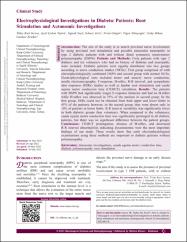Electrophysiological investigations in diabetic patients: Root stimulation and autonomic investigations

Göster/
Erişim
info:eu-repo/semantics/openAccessTarih
2023Yazar
İncesu, Tülay KurtTaksin, Aysel Çoban
Seçil, Yaprak
Arıcı, Şehnaz
Gürgör, Nevin
Tokuçoğlu, Figen
Akhan, Galip
Ertekin, Cumhur
Üst veri
Tüm öğe kaydını gösterÖzet
Introduction: The aim of the study is to search proximal nerve involvement
by using proximal root stimulation and possible autonomic neuropathy in
type 2 diabetic patients with and without distal symmetric sensorimotor
polyneuropathy (DSPN). Patients and Methods: Forty patients with type 2
diabetes and ten volunteers who had no history of diabetes and neuropathy
were included. Diabetic patients were equally distributed into two groups
according to nerve conduction studies (NCSs): First group comprised of with
electrophysiologically confirmed DSPN and second group with normal NCSs.
Electrophysiological tests included motor and sensory nerve conduction,
needle electromyography, F‑response, H‑reflex, R‑R interval, and sympathetic
skin responses (SSRs) studies as well as lumbar root stimulation and cauda
equina motor conduction time (CEMCT) calculation. Results: The patients
with DSPN had significantly longer F‑response latencies and had no H‑reflex
while H‑reflex was observed in 35% of the patients in second group. In the
first group, SSRs could not be obtained from both upper and lower limbs in
45% of the patients; however, in the second group, they were absent only in
10% of patients in lower limbs. R‑R interval variability was significantly lower
in both diabetic groups than volunteers. When compared to the volunteers,
cauda equine motor conduction time was significantly prolonged in all diabetic
patients, but there was no significant difference between the patient groups.
Conclusions: CEMCT prolongation, absence of H‑reflex, and decreased
R‑R interval abnormalities indicating dysautonomia were the most important
findings of our study. These results show that early electrophysiological
examinations using these methods are important in diabetic patients without
polyneuropathy.

















